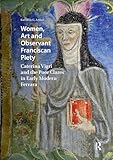Women, Art and Observant Franciscan Piety : Caterina Vigri and the Poor Clares in Early Modern Ferrara / Kathleen Giles Arthur.
Material type: TextSeries: Visual and Material Culture, 1300 -1700 ; 2Publisher: Amsterdam : Amsterdam University Press, [2018]Copyright date: ©2018Description: 1 online resource : 8 color plates, 59 halftones, 6 line artContent type:
TextSeries: Visual and Material Culture, 1300 -1700 ; 2Publisher: Amsterdam : Amsterdam University Press, [2018]Copyright date: ©2018Description: 1 online resource : 8 color plates, 59 halftones, 6 line artContent type: - 9789462984332
- 9789048534999
- Art and religion -- Italy -- Ferrara -- History -- 15th century
- Monasticism and religious orders for women -- Italy -- History -- To 1500
- Nuns as artists -- Italy -- Ferrara
- Women -- Religious life -- Italy -- Ferrara -- History
- Stiftung
- Architektur
- Ausstattung
- Christliche Kunst
- Klosteranlage
- HISTORY / General
- 709.945 22
- BX4634.F4 A78 2018eb
- online - DeGruyter
- Issued also in print.
| Item type | Current library | Call number | URL | Status | Notes | Barcode | |
|---|---|---|---|---|---|---|---|
 eBook
eBook
|
Biblioteca "Angelicum" Pont. Univ. S.Tommaso d'Aquino Nuvola online | online - DeGruyter (Browse shelf(Opens below)) | Online access | Not for loan (Accesso limitato) | Accesso per gli utenti autorizzati / Access for authorized users | (dgr)9789048534999 |
Browsing Biblioteca "Angelicum" Pont. Univ. S.Tommaso d'Aquino shelves, Shelving location: Nuvola online Close shelf browser (Hides shelf browser)

|

|

|

|

|

|
No cover image available | ||
| online - DeGruyter Outlawry, Liminality, and Sanctity in the Early Medieval North Atlantic / | online - DeGruyter On Building Peace : Rescuing the Nation-state and Saving the United Nations / | online - DeGruyter African-Asian Encounters : New Cooperations and New Dependencies / | online - DeGruyter Women, Art and Observant Franciscan Piety : Caterina Vigri and the Poor Clares in Early Modern Ferrara / | online - DeGruyter The Rhetorical Arts in Late Antique and Early Medieval Ireland / | online - DeGruyter Tolerance, Intolerance, and Recognition in Early Christianity and Early Judaism / | online - DeGruyter Shapeshifters in Medieval North Atlantic Literature / |
Frontmatter -- Contents -- List of Plates and Figures -- Acknowledgments -- Abbreviations -- Introduction -- 1. The Pious Women of Corpus Christi -- 2. Building a Public Image of Piety -- 3. The Sette Armi Spirituali and its Audience -- 4. Drawing for Devotion: Sister Caterina's Breviary -- 5. Corpus Christi's Later Religious and Civic Identity -- Conclusion -- Notes -- Appendix I -- Appendix II -- Bibliography -- Index
restricted access online access with authorization star
http://purl.org/coar/access_right/c_16ec
Caterina Vigri (later Saint Catherine of Bologna) was a mystic, writer, teacher and nun-artist. Her first home, Corpus Domini, Ferrara, was a house of semi-religious women that became a Poor Clare convent and model of Franciscan Observant piety. Vigri's intensely spiritual decoration of her breviary, as well as convent altarpieces that formed a visual program of adoration for the Body of Christ, exemplify the Franciscan Observant visual culture. After Vigri's departure, it was transformed by d'Este women patrons, including Isabella da Aragona, Isabella d'Este and Lucrezia Borgia. While still preserving Observant ideals, it became a more elite noblewomen's retreat. Grounded in archival research and extant paintings, drawings, prints and art objects from Corpus Domini, this volume explores the art, visual culture, and social history of an early modern Franciscan women's community.
Issued also in print.
Mode of access: Internet via World Wide Web.
In English.
Description based on online resource; title from PDF title page (publisher's Web site, viewed 20. Sep 2019)


